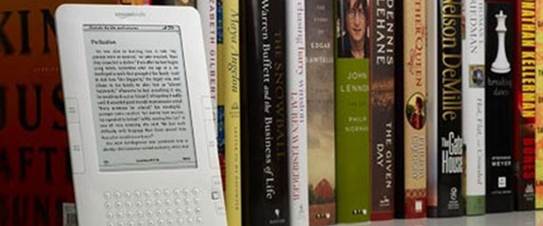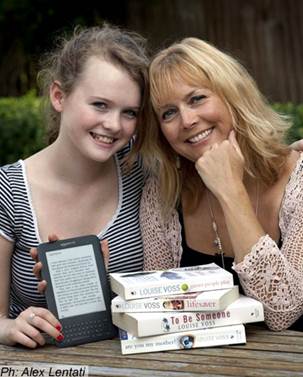Like to write a book, but fear you couldn’t
get a publisher? Olivia Gordon outlines another route
Every aspiring author would love a book
deal and now the growth of ebooks is changing the face of publishing. It’s true
there are many self-published ebooks that don’t attract readers, but there have
also been amazing success stories (see right).

Ebooks are now outselling printed books on
Amazon, and publishers are recognizing this opportunity and setting up ebook
imprints.
The key advantage is, instead of being paid
a royalty of ten to 15 per cent, you can take as much as 85 per cent – though
remember ebook prices are lower than print books. Plus your books will share
virtual shelf space with names such as Dan Brown or Nigella Lawson, because
ebooks are categorized by genre.
Where to start
So you’ve written your fabulous cookbook or
gripping thriller as a 200-pages Word document. The next step is to choose how
to convert it into an ebook. Companies offering to publish and sell your ebook
spring up weekly, but here are the two most popular…
Amazon’s kindle direct publishing (kdp.amazon.com)
Through KDP, your books will be available
at the Kindle Store, where most ebook sales happen. It’s also the most
straightforward way to publish your ebook, and Amazon offers a step-by-step
guide to formatting your document.
Your book will still be judged by its
cover, so it’s vital to make it look as professional as possible. You can pay a
company such as lighthouse24.com to do it for you – they charge from around
£60.
If you’d like someone to proofread your
book, you’ll find a directory of proofreaders at sfep.org.uk.
Once your book is ready, upload it at
kdp.amazon.com. You’ll be asked for basic information, including a compelling
description in fewer than 4,000 characters. Next, enter two “categories”
(options include romance and cooking) – to help Amazon list your book.
Historical fiction, vampires and young adult books are all popular genres. You
also need to think of some “keywords” to describe your book – buyers who search
for these keywords will be directed to your book.
Next comes pricing – self-publishing is
free on Kindle, but when pricing, a rule of thumb is, if you charge the 75p
minimum, you get a 35 per cent royalty on each book sold; if you charge over
$2, your royalty will be 70 per cent. Look at what other books in your genre
are selling for – then often yours for a lot less. People are more likely to
take a chance on an unknown author if the price is lower.
Once uploaded, your book will hit the store
within 48 hours.
Amazon Kindle also offers a “CreateSpace”
service, which prints copies of your book on demand – you pay the printing
costs.
Smashwords (smashwords.com)
Like its main rival, lulu.com, Smashwords
allows you to self-publish and distribute not just at the Kindle store, but to
other ereaders.
To make your book widely available, publish
direct to the Kindle Store and use Smashwords for your other ebookstore sales.
Kindle doesn’t use ISBNs, but Smashwords will issue you with one for free,
which you can then use to list your book anywhere else. If you start by listing
your book on a different site, you will have to apply for an ISBN yourself.
This costs from around £120 and takes around ten days to receive – see
isbn.nielsenbook.co.uk.
Smashwords’ method is much the same as
Kindle, but you can choose where to distribute your book (option include Apple
iBooks, and Barners & Noble)
If you publish via Smashwords, you get 60
to 70 per cent of profits for sales made from the websites it distributes to,
or 85 per cent of profits on sales directly from Smashwords’ store. You’re paid
via PayPal.

“My self-published ebook got me a
six-figure publishing deal”
Louise Voss, 42, from Surrey, got a
four-book deal with HarperCollins. “I’d always wanted to write a novel and had
written a couple of manuscripts that had been rejected. Then I watched a
documentary about aspiring writers – one man featured was Mark Edwards. I wrote
to him, and soon, we decided to write a book together. We self-published it as
an ebook on Amazon and emailed everyone we knew to ask them to buy the book.
Then we approached online reviewers. When it started going up the charts, it
was surreal; We were outselling Michael McIntype and Stieg Larsson! We made
around £20,000 from the combined sales of Killing Cupid and our second book,
Catch Your Death. Then we were contacted by HarperCollin, and it feels like all
the hard work has paid off”.
Use social media to create a buzz
Social media like Twitter are crucial in promoting your book. On Twitter, use the hashtag (#)
to help spread the word - #cookbooks, #ebooks, #romance.
Set up a Facebook page for your book for people to “like”. Create an author page on
Amazon, your own website and a blog for your book (try wordpress.com). Link
them to your social media pages.
Be creative,
spark debate and get people talking. When Talli Roland was promoting her enovel
Build A Man, she asked contacts to put together a picture of their ideal man at
beatybitsblog.blogspot.com and used her Facebook and Twitter to drum up
attention – she ended up on Amazon’s bestseller list.
Amazon makes
ten per cent of an ebook available as a free ample, so make sure your first few
pages are gripping and throw in a cliffhanger.
Contact book bloggers – there are hundreds listed at britliblogs.com. Contact blogs
individually, telling them about your book to your email. Popular book blogs
include dovegreyreader.typepad.com, trashionista.com,
stuck-in-a-book.blogspot.com, goodreads.com and the Guardian books blog.
Add a message to the end of your ebook, asking for readers to leave a review on
Amazon.